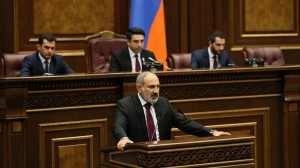 Participating in the Tbilisi Silk Road Forum in Georgia, Pashinyan outlined his government’s plans to cooperate with neighboring countries and open up to the world through road, rail, and energy links.
Participating in the Tbilisi Silk Road Forum in Georgia, Pashinyan outlined his government’s plans to cooperate with neighboring countries and open up to the world through road, rail, and energy links.
Pashinyan said his landlocked country should be connected to the Black Sea, the Mediterranean, the Caspian Sea, and the Persian Gulf as soon as possible by joining projects with its neighbors to open up transit routes. As well as connecting Armenia to the sea, these would provide links between Georgian Black Sea ports and the Gulf, he told the forum in late October.
He announced that steps will be taken to open the borders with Turkey and Azerbaijan “in the near future,” bringing “positive stimulus” to the whole region.
The continued closure of the borders with Turkey and Azerbaijan reflects Armenia’s regional isolation since the early 1990s, which resulted from its victory against Azerbaijan in the first Nagorno-Karabakh war and its ultimate defeat this year.
During that period, it lost the opportunity to host important infrastructure projects, including the Baku-Tbilisi-Ceyhan oil pipeline and the Baku-Tbilisi-Erzurum natural gas pipeline, as well as the Baku-Tbilisi-Kars railway. These projects have instead been routed through Georgia, albeit at a slightly higher cost.
Since 2020, after the regional fallout from the Second Karabakh War, the Armenian government has signaled its willingness to adapt to the new geopolitical realities and Pashinyan has expressed a hope that a final peace agreement with Azerbaijan will be signed soon. A peace treaty is the only way out of isolation and Pashinyan’s approaches, which can be considered radical in terms of Armenia’s political tradition, should be seen in this light.
At the same time, Azerbaijan’s proposal to open a Zangezur Corridor was not well received in Armenia. The corridor, which aims to connect Armenia’s Syunik region with Turkey and Nakhchivan in Azerbaijan, was purportedly aimed at Armenia’s direct participation in regional projects. Some in Armenia argued it would mean the loss of sovereignty in the region, while others saw it as a means for Azerbaijan to gain the upper hand.
Iran’s reaction also played a crucial role in opposition to the corridor. It said the proposal would amount to a NATO presence in the region (because of Turkey’s membership.) Azerbaijan, which had argued the corridor was the easiest way for Armenia to achieve regional integration and develop transport lines, has since announced it was no longer important.
Pashinyan, who unabashedly expressed his discomfort with the Russian military presence in his country and the need to “diversify” security links, reflected the national anger at the Kremlin’s refusal to offer military support during its recent conflicts.
Talks with France in the field of military cooperation have made some progress — including the purchase of ground radars, air defense systems, and missiles. The deployment of French security experts as consultants has also been discussed. As a result, military expenditure is expected to increase to $1.4bn in 2024 from $800m in 2022. But this is unlikely to change the military balance, where Azerbaijan enjoys a very considerable edge.
Armenia is currently at a crossroads. The abandonment of traditional policies in favor of regional integration is in its earliest stages.
The government’s aspirations will be clear in any final peace agreement with Azerbaijan, but bypassing an already hostile Russia could create consequences. The Pashinyan government will need the support of Western countries more than ever.
Dr Mehmet Fatih Oztarsu – CEPA
https://cepa.org/article/armenia-needs-help-to-escape-regional-isolation/

 Kasım 15th, 2023
Kasım 15th, 2023  oztarsu
oztarsu  Posted in
Posted in  Tags:
Tags: